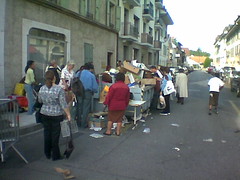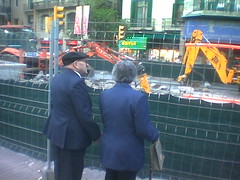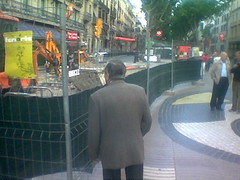Posted: May 22nd, 2006 | No Comments »
From Gregor Broll’s presentation of Exploiting Seams in Mobile Phone Games at the PerGames 2006 Workshop at the Pervasive, Dublin Ireland

Relation to my thesis: I expect to go deep in defining the technical sources of uncertainties (it might be more than inaccuracies) in order to investigate ways to incorporate spatial uncertainties in the design of ubicomp environments.
Posted: May 22nd, 2006 | 1 Comment »
Ian Anderson and Henk Muller. Context Awareness via GSM Signal Strength Fluctuation. In: the 4th International Conference on Pervasive Computing, Late breaking results, pages 27–31. Oesterreichische Computer Gesellschaft, May 2006.
Abstract. In this paper we demonstrate how a cell phone can infer contextual information such as mode of travel by monitoring the fluctuation of GSM signal strength levels and neighbouring cell information. We show that these signals are stable enough to reliably distinguish between various states of movement such as walking, travelling in a motor car and remaining still. We present preliminary results for a metropolitan
environment.
Relation to my thesis: I am involved in a similar project that aims at sensing mobility. The authors’ artificial neural network for fusing GSM signals is inspiring. However, it creates occasional errors in detecting the motion. Moreover, as the neural network is adapted to metropolitan areas, an adaptation of its sensitivity would need to be performed for rural areas. Raising the question on how to detect an area.
Posted: May 19th, 2006 | 1 Comment »
Developed by Adrian Herzog, MAPresso is a Java applet that creates cartograms and choropleth maps.

Example of world population under the age of 15 in 2003
Via Cartogtaphy
Relation to my thesis: Interested in cartograms and new ways to display spatial data.
Posted: May 18th, 2006 | No Comments »
Today and tomorrow I take part to a workshop on the Future of Web Search, held at the UPF Barcelona.
My good friend Mauro Cherubini will present his work on Mobile Search on Ubiquitous Collaborative Annotations of Space.
For credits in the doctoral school, I will need to write a paper on the very specific topic of Efficient Top-k Queries for XML Information Retrieval, that will be part of Gerhard Weikum‘s keynote speech
Abstract
Non-schematic XML data that comes from many different sources and inevitably exhibits heterogeneous structures and annotations (i.e., XML tags) cannot be adequately searched using database query languages like XPath or XQuery. Often, queries either return too many or too few results. Rather the ranked-retrieval paradigm is called for, with relaxable search conditions, various forms of similarity predicates on tags and contents, and quantitative relevance scoring.
The talk discusses recent advances and open research issues for ranked retrieval of XML data, and exemplifies them by the TopX search engine, a prototype system developed at the Max-Planck Institute for Informatics. TopX supports a probabilistic-IR scoring model for full-text content conditions and tag-term combinations, path conditions for all XPath axes as exact or relaxable constraints, and ontology-based relaxation of terms and tag names as similarity conditions for ranked retrieval. For speeding up top-k queries, various techniques are employed: probabilistic models as efficient score predictors for a variant of the threshold algorithm, judicious scheduling of sequential accesses for scanning index lists and random accesses to compute full scores, incremental merging of index lists for on-demand, self-tuning query expansion, and a suite of specifically designed, precomputed indexes to evaluate structural path conditions.
Posted: May 17th, 2006 | No Comments »

This container filled with carton boxes was a main attraction at one of Geneva’s flea market.
Carton boxes are crucial items that help us move and archive our lives. What are the digital carton boxes? USB sticks? Gmail accounts?
Posted: May 12th, 2006 | No Comments »


Related to: Gens qui Regarde les Chantiers
Relation to my thesis: Visible seams. Noticing the evolving physical space, is there a virtual counterpart?
Posted: May 11th, 2006 | 1 Comment »
I have presented my first “naive” models of spatial uncertainty in the context of ubicomp. There have been considered as a starting framework. While I should consolidate them, he mentioned that I should now provide a point of view. A simple one to start would be “what can we improve?”. This is probably the point of view I will take with the context of CatchBob! to submit a poster to UbiComp 2006.
Uncertainty induced by human interaction is not in the context of my work. Therefore he advised to mention in my model the excluded elements and, if the model gets too sterile, reintegrating them. I still need to take a stand on whether I should take into consideration a shared representation of location (i.e. location awareness in collaborative setting) or focus on the individual. A natural process for me would be to start focusing my models on the individuals and then enrich them with a collaboration perspective.
Starting from the model on location representation, I could investigate the dynamic of the interaction of the users with the representations and the space in the context of uncertainty. I never considered the ideas of evolution and dynamism.
He came up with the concept of “unavoidable errors” from numerical analysis and its inherence in computing.
Posted: May 10th, 2006 | No Comments »
MIT’s Carlo Ratti (from SENSEable City, they group behing Real-Time Awareness Maps of Cell Phone Usage gives an interview (Real-Time Maps May Create Better Cities) in Technology Review. He talks about the use of the real-time generated by the people’s use of radio-frequency beacons (GSM antennas, WiFi access points, …) to better understand the use of space. The rest of the interview is on privacy issues.
The answer to the question “How can people use real-time location data?” is a bit rough, and I surely would be interested to know more:
Carlo Ratti: This information becomes very interesting because it can create a feedback loop. When you give this information to the community, the community can change its behavior.
Relation to my thesis: I am interested in location awareness from the collection of sensed location to their collaborative use with an emphasis on supporting people in dealing with the “noise” blurring location data. The real-time feedback loop on spatial use mentioned by Carlo Ratti is truly new, and it is absolutely unclear on the how/what/when such information should be given to be useful (or at least armless). Nicolas’ work on CatchBob! surely cannot be generalized and scaled up, but it at least give hints on the complexity of location awareness mechanisms.
Posted: May 9th, 2006 | No Comments »
Motorola wants to patent “Method and apparatus for evaluating locations according to Feng Shui principles. Feng Shui is the Chinese practice of positioning objects, especially graves, buildings, and furniture, based on a belief in patterns of yin and yang and the flow of chi that have positive and negative effects.
The table with the chi values of each parameter is stored in phones memory and is used for calculation of chi values of different parameters.

via Unwired View
Relation to my thesis: Fusion of sensors (3D hall-effect sensor, digital camera, GPS (-> GIS database), microphone, AM/FM transmission strength and distance to towers) on a mobile device to change the perception of space.
Posted: May 9th, 2006 | No Comments »
Baecker, R. M., Grudin, J., Buxton, W. A., and Greenberg, S. 1995. Research frontiers in human-computer interaction. In Human-Computer interaction: Toward the Year 2000, R. M. Baecker, J. Grudin, W. A. Buxton, and S. Greenberg, Eds. Morgan Kaufmann Publishers, San Francisco, CA, 739-740.
This is a rather old article from the Human-computer interaction: toward the year 2000. book which predicted some areas that interest me:
Co-evolution and design for appropriation
Designing for human capabilities is challenged by rapid changes in environments that require mutual fit and adaptation of humans and computer.
The utopia in ubicomp
Finally, ubiquitous computing represents a profound shit in perspective. [..] Virtual communities, virtual reality, and ubiquitous computing, in particular, bring with them bright utopian and dark anti-utopian visions.
Relation to my thesis: Looking for some articles giving an overview of HCI to give a very high-level HCI context to my research.







